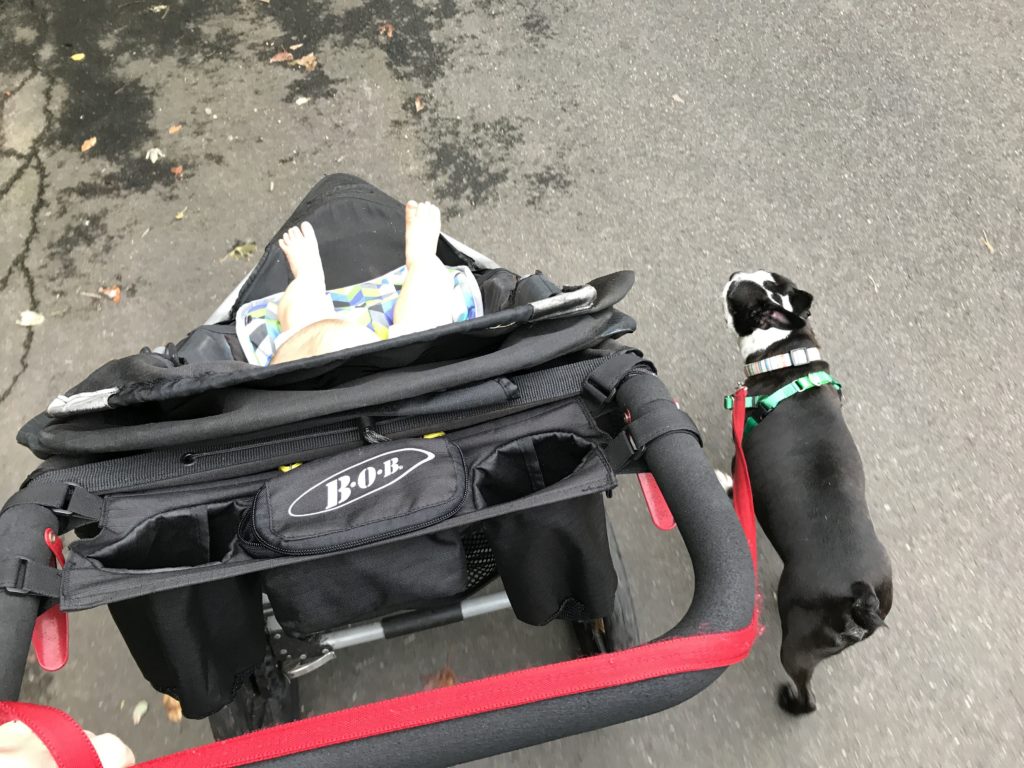Excerpt chapter one – ‘The Ruff Wait for Baby’

Some dogs will get used to these things on their own and some will fear them and associate that fear with the baby who uses and engages with them. The first option is not great because we want our dogs to love our children, not get used to them. The second is bad because we don’t want our dogs to fear our children.
If you wait to expose your dog to the new gizmos when they are in use with the new baby, you won’t know if your dog is reacting to the gizmo or the baby in it, or both. If, however, you begin exposing your dog to the new gizmos as they come into the house, you will be able to begin the desensitization process. And if you see your dog is scared or leery of an item, you can begin the counter-conditioning process.
Baby gizmos include the following and more:
- Those lovely automatic swings that play music and might even have a mobile dangling above it. This can be scary to your dog, or a great toy.
- Portable car seats that will be carried right at many dog’s eye level often have interesting smells in them that can draw a dog in to investigate
- All the vibrating, dancing, quacking, and you-name-it toys could frighten your dog or have your dog thinking these are new toys for him or her
- The Pack-n-Play is often dismissed as just a piece of furniture, but it vibrates, plays music, and often has lights. This too can be scary for your dog or very tempting.
- The baby monitor is also often overlooked. If you use the type that sends the image to your electronic devices, it probably won’t be an issue, but if you use the standard monitor that has the portable unit to transmit sound, don’t forget that to your dog, this can be a box with a baby stuffed into it.
- Strollers can be scary, something to chase, or something to pull.
Desensitization and counter-conditioning (DS/CC)
Desensitization is making the dog less sensitive around a trigger. Counterconditioning change your dog’s associations and emotions to be more positive about the trigger.
The trigger can be anything a dog is unfamiliar with, afraid of, or really excited by.
It is not enough for your dog to just see a trigger or be around a trigger to desensitize her. You have to be careful to expose her to the trigger only at the point at which she can tolerate it without reacting—this is called sub-threshold. This type of exposure will desensitize her over time. But that may not be enough either if she is already afraid of the trigger—then we have to change her emotions, too, by pairing the sub-threshold exposure with a primary reinforcer that is of high enough value that she and her brain are totally wowed.
For some dogs a super-high-value primary reinforcer could be cheese, for others a tennis ball. But it can be anything and everything in between as well. Your dog has to tell you what her most valuable primary reinforcer is—and generally your praise will not be enough, though it should definitely be in the mix.
If you are matching the presentation of the primary reinforcer effectively with the trigger, soon your dog will be consciously looking forward to the trigger. Then later, through neuroplasticity, her brain will physically change the signals it sends along her neural pathways when the trigger appears. Instead of her “That scares me,” signal, her neurons will be sending the “I love that thing” signal. Later, we can change her behavior when she is near the trigger by asking for a sit or a settle.

Socializing and classical conditioning prevent having to do a lot of desensitizing and counterconditioning.
These are done to help the dog avoid developing a negative association with things she is meeting for the first time, as opposed to undoing a negative emotional response already in place. For example, if we take the myriad baby gizmos that your dog may not have seen previously, and introduce her to these things by placing a string of treats on the floor around and leading up to the gizmo, she will likely look at these things and say,
“Hum, that’s strange and it seems to come with treats—yeah!” or something to that effect.
If your dog is already fearful, we have to go slowly in terms of taking her closer to the object or extending the length of time she is exposed to it. It is important to allow your dog to move toward and away from the new object, at her discretion. Like all of us, she will feel more comfortable around the scary object when she can control how close she is to it. Patience is essential for this.
Often people recommend flooding—exposing the dog to triggers up close and without regard for the dog’s state of mind, saying, “Just force him and he will see it’s not scary.” Although this may work on rare occasions, the majority of the time the dog will walk away more fearful.
As always, if things are not going well between your dog and your baby, toddler, or even older child, contact a certified trainer, behavior consultant, or behaviorist,:
- http://www.iaabc.org,
- http://www.ccpdt.org,
- https://avsab.org/resources/behavior-consultants-near-you/
Good luck and enjoy!